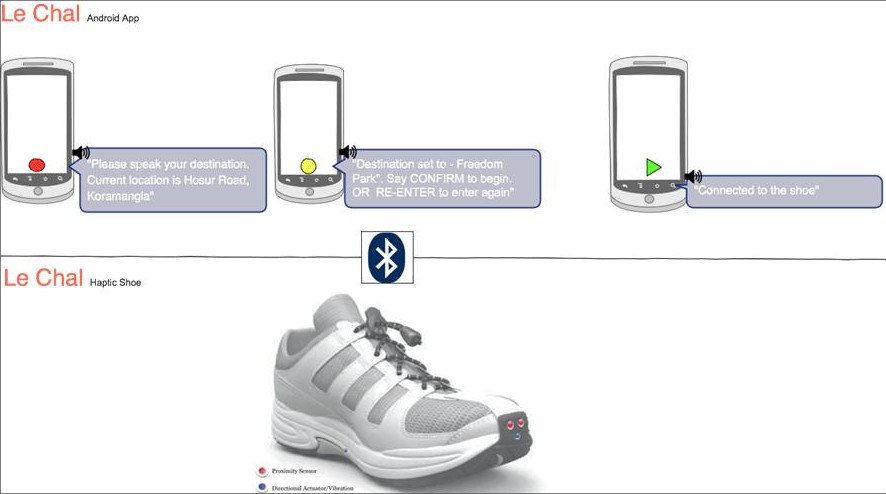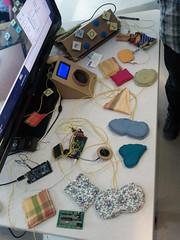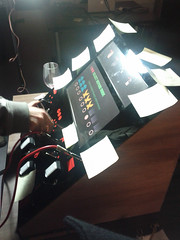PLUG-AND-PLAY FOR ARDUINO
– November 4th, 2011
Here is a good news for the creative at heart non-programmers!
Minibloq is a graphical programming environment for Arduino™, Multiplo, physical computing devices and robots. One of it’s main goals is to bring closer physical computing and robotic platforms to primary schools, kids and beginneers.
It comes with a good documentation and is the outcome of a kickstarter campaign.
Source: minibloq
ARDUINO CIRCUIT BENDING WORKSHOP IN TORINO
– November 2nd, 2011

Il prossimo week-end a Torino si terrà un workshop gratuito di Arduino (un kit opzionale potrà essere comprato per partecipare qualora non disponeste dei materiali elencati) sul circuit bending e la generazione di suoni con la scheda.
Un workshop di tre giorni per smontare riciclare e far suonare vecchi strumenti elettronici, creare una digital toys orchesta e sfilare in parata a Paratissima.Il circuit Bending è una pratica molto diffusa tra gli sperimentatori musicali. Soprattutto sulla scena della musica elettronica sono sempre più frequenti gli artisti che si creano controller o addirittura strumenti musicali personalizzati.Nel workshop saranno coinvolte diverse discipline: toy hacking, riciclo elettronico, elettronica di base, sintesi sonora, programmazione ad oggetti e faremo largo uso di Arduino per comandare i nuovi strumenti.Il workshop è gratuito, a carico dei partecipanti il costo dei materiali e l’acquisto del kit-workshop.
maggiori informazioni quì!
Per partecipare registrati qui.
via [FablabItalia]
DIRECTIONAL SHOES FOR THE BLIND
– November 2nd, 2011
Sometimes, it is amazing to see how technology is used to make the world a better place to live for the less fortunate. One such problem has been thought out and tackled by Anirudh Sharma aka touchaddict on IRC. His invention is called ‘Le-chal’ which translates to ‘Take me there’ in Hindi.
Sharma conceptualized and demonstrated the system at MIT (Massachusetts Institute of Technology) Media Lab Design and Innovation Workshop 2011.The Le Chal system comprises of a pair of shoes, one of which is fitted with Vibrators, proximity sensors and a Bluetooth pad which is connected to an Android phone that calculates directions and real time location using Google Maps and the phone’s built-in GPS and compass module.
For all the people calling Arduino a ‘toy’ and ‘too simple’ here is a fact: it’s simplicity gave the inventors the power to rapidly prototype, and the invention was ready in 6 days.
As per his presentation, the system costs barely a few hundred rupees to assemble with 8 mini vibrational motors costing Rs 90, a sole of specified dimensions, an Arduino Lilypad GSM+GPS shield custom made for Rs 400 or a wired version costing Rs 150 for all the components.
The shoes have also been tested at a blind school in Bangalore, India, and have received positive reviews.
Source: Medianama and Pixelonomics
BALL OF DUB KEEPS AUDIO IN YOUR HANDS
– November 1st, 2011
Accelerometer to Renoise via OSC to control trippy and dubby sounds.
[Lizzie] from LustLab sent in her Ball of Dub that turns a few accelerometer and a digital audio workstation and turns everything into an aural experience of wubs and dubs. The Ball of Dub can turn just about anything into dubstep, and does so with a fairly interesting user interface.There isn’t a build log for the Ball of Dub, but the folks at LustLab did send in a basic overview of her project. Inside the ball, there’s a Razor IMU from Sparkfun that is attached to the ever-popular XBee wireless transceiver. A tiny program on an Arduino calibrates the gyroscope and accelerometer and sends that data to the DAW at 50Hz.The host computer is running Renoise, a very popular tracker that can accept MIDI and OSC input. A Processing app parses the ball spin, free fall and impact, averages them over a period of time, and pipes that into the OSC input of Renoise. In [Lizzie]‘s video, the ball spin is sent to a low-pass filter on the baseline track, and the average impact is applied to the vocal track.
via [HackADay] source [LustLab Tumblr] special demo video for the few skeptical comments on HackADay
ARDUINO AND FLEX TO CONTROL A CREEPY SKULL
– November 1st, 2011
Cool & creepy Adobe Tutorial by Davic Benge using Arduino and Flex on how to animate a skull. We have previously covered a very nice video tutorial by Kevin Hoyt on Arduino to Flash communication.
via [Adobe]
HAPPENINGS IN TORONTO
– October 31st, 2011

Just got back from Toronto, where I attended events at Toronto Digifest andTIFF Nexus. I was very impressed with all the interesting work happening there. I gave a presentation at DigiFest on Arduino, Physical Computing and Mass Participation (PDF, 25.9MB). At TIFF Nexus I was a commentator on thePeripherals Initiative along with Steve Daniels, John Bouchard, and Emilie McGinley.
On Thursday Kate Hartman took me to visit her Social Body lab at OCAD University. After that, we went to visit Lawrence at Creatron, a local retailer of electronics parts for hobbyists. I am envious of the electronics hackers in Toronto because of that store! Lawrence carries all the stuff I and my students buy online all the time: microcontrollers, modules from online retailers like Adafruit and Spark Fun and individual components like resistors, LEDs, and much more. He told me he works directly with his friends and colleagues in Hong Kong to import parts directly, so as to cut out the middleman and keep prices low. I tried to talk him into opening a store in New York City as well. We need you in NYC, Lawrence!
The Digifest talk was a great experience, thanks to organizers Luigi Ferrara, Nick Crampton, Samantha Fraser and the rest of the Digifest TO team. Thanks also to Maria Grazia Mattei and Giulia Capodieci of Meet the Media Guru for inviting and hosting me as well.Thanks to all the folks in the audience who asked really great questions as well.
On Friday Steve, John, and Ramona Pringle gave me a tour of Ryerson’s Digital Media facilities. Ryerson’s just finishing off the renovation of their Image Arts gallery, which looks like it’ll be a good space for showcasing student and faculty work. The building has a skin of LED panels, all of which are software-controllable, and John and his colleagues have been writing driver software for it. I look forward to seeing images from it when it’s lit up, and seeing what students do with it when they get their hands on it. We also took a tour ofRyerson’s Digital Media Zone business incubator, and had a great chat withJason Nolan about the work EDGElab is doing in assistive design. He showed me an Arduino-based keyboard emulator designed by Vlad Cazan that was built to help a young girl with 1P36 deletion syndrome to communicate.
The TIFF Nexus peripherals event featured five hardware and software game hacks developed by teams who signed up for the event. Sadly, I only got to play two of them before I had to leave. Button Masher (again featuring Vlad and Alex Bethke of Golden Gear Games) is made up of two panels of hexagons of large light-up buttons, a sort of 21st century wack-a-mole, but with a variety of different games you can play on it, from snake trap to an Othello-like board game. Analog Defender, by Alexander Martin and Patrick Dinnen is a space game in the style of Space Invaders, but with a control panel made of great chunky industrial control knobs and buttons. The interface is pretty complicated but unlabled, and the developers encouraged players to label the controls with post-it notes as a form of social labeling. I loved the way you end up collaborating with people who played before you as a result.
It was a great trip, and it was wonderful to see so many folks using Arduino in really creative ways in Toronto.
DRAWING ROBOT, RANDOM GRAFFITI
– October 27th, 2011
Cool drawing robot from So Kanno and Takahiro Yamaguchi, from “UTOPIA no OSHIRASE” exhibition in Tokyo.
Senseless Drawing Bot is a 4-wheeled graffiti machine, with a pendulum arm, arduino and spray cans to create random strokes as it moves up and down the gallery space.
via [creativeApplications]
LINUX DAY, SABATO 22 OTTOBRE 2011
– October 20th, 2011
Arduino non può che condividere e rinnovare – anche per quest0′anno – l’invito al Linux Day, il 22 Ottobre prossimo (questo sabato). Linux non é solo il sistema operativo opensource che proprio nel 2011 compie vent’anni. E’ anche il punto di riferimento per moltissimi strumenti di tutti i giorni che molti di noi usano:android, per esempio, ed ovviamente Arduino.
A margine di questo invito, volevo – come l’anno scorso – cercare di elencare qui di seguito i linux days che ospiteranno una presentazione su Arduino.
- Massimo parlerà al linux day di Milano.
Commentate per vedere questa lista aggiornata!
HC-SR04 ULTRASONIC ARDUINO LIBRARY
– October 20th, 2011

This is nice. I hope Carl posted the library in the Census
Carl Nobile has developed and released an Arduino library covering the HC-SR04 ultrasonic sensor. He writes: “It features timing, metric conversion, and standard deviation methods, plus a few support methods. It is written in C++ to conserve the namespace. The conversion formula can be easily modified to optimize the accuracy of conversion at different distances for inches and centimeters. Multiple buffers of different lengths can be created for determining standard deviation.Look at the code and examples to understand how the library works. The standerd deviation code can be removed from the compilation resulting in a significant savings of resources. To do this comment the #define COMPILE_STD_DEV definition in the header file.”
via [dangerousPrototypes] downlaod the library from [FreshMeat]
REMIX DOMESTIC APPLIANCES
– October 18th, 2011
[Elvia Vasconcelos] developed a very simple yet interesting installation based on PureData and Arduino. The main goal is change / remix (and therefore innovate) the approach toward domestic appliances:
To re-purpose an object is to manipulate its construction. I believe there is nothing natural about the way objects behave and therefore in their potential to be reinvented. It is in the artistic domain to liberate these objects from the settings in which they have become predictable and accepted. For this installation I am looking at objects from the Home. I present a fan, an extractor, a light bulb and a vacuum cleaner that are pretending to be toasters. They are controlled by the viewer via a telephone. My work is guided by a desire to hold onto things but not exactly to hold them in place.














0 comentarios:
Publicar un comentario